Otsu Matsuri Festival 大津祭
|
Title   • File Name • File Name   • Date • Date   • Position • Position   |
|

Otsu Matsuri is one of Shiga's major festivals featuring thirteen ornate floats displayed and paraded around central Otsu over two days before Sports Day, a national holiday around Oct. 10.
|
|

The first day of the festival has the floats parked and displayed on the streets and lit up at night. The first day of the festival is called Yoimiya. (This was Oct. 11, 2008.) 宵宮
|
|

During the first day, the karakuri mechanical puppets are removed from the floats and displayed on street level. The karakuri ningyo puppets are a major highlight of the floats and festival. The puppets perform on the floats during the procession.
|
|

The Otsu Matsuri has thirteen floats called hikiyama. Each one belongs to a different neighborhood in central Otsu. Each float has a name and features ornate carvings, tapestries, paintings, and other art work.
|
|

Karakuri puppet from Ryumon Taki-yama on display. At Otsu Station, maps and pamphlets about the festival are available.
|
|

The floats also have elaborate tapestries, also removed for public display at street level. Two floats have tapestries depicting the Sack of Troy from Greek mythology.This one is from the Ryumon Taki-yama float.
|
|

My YouTube video of Otsu Matsuri filmed on Oct. 12-13, 2013. Shows the Yoimiya and Hon-matsuri main festival day.Otsu Matsuri is one of Shiga's major festivals featuring thirteen ornate floats displayed and paraded around central Otsu over two days before Sports Day, a national holiday around Oct. 10.
|
|

Daytime view
|
|

Nighttime view
|
|

Daytime view. The distinguishing feature of Otsu Matsuri floats is that they have three wheels instead of four (as with Kyoto's Gion Matsuri).
|
|

Nighttime view during Yoimiya at Otsu Matsuri. Yoimiya is similar to the one held during the Gion Matsuri in Kyoto. 宵宮
|
|
|

Karakuri dolls from Nishinomiya Ebisu-yama float.
|
|
|

Otsu Matsuri floats look better at night with the lanterns lit. Seeing the festival eve is well worth it. It's not so crowded either.
|
|

This float (called Seio Bo-zan) is inside the Maruya-cho shopping arcade. 丸屋町
|
|

Inside a shopping arcade near the Otsu Matsuri Hikiyama Museum. There weren't any floats where we could actually enter.
|
|

Otsu Matsuri lantern
|
|

Otsu Matsuri Hikiyama Tenjikan Museum (free admission) is in the Maruya-cho shopping arcade. 大津祭曳山展示館
|
|

Inside Otsu Matsuri Hikiyama Museum is a life-size model of the Seiobo-zan (西王母山) float featuring a longevity peach and peach boy. 大津祭曳山展示館
|
|

Performance outside the Otsu Matsuri Hikiyama Museum.
|
|

Sesshoseki float at Otsu Matsuri.
|
|
|

Lit lanterns and lit float.
|
|
|
|

Between the Yutate-yama and Jingu Kogo-yama floats, they held a little event featuring the musicians from both floats.
|
|
|

As well as Otsu Hikaru-kun, official mascot of Otsu. He is based on the Genji Monogatari (Tale of Genji) character. おおつ光ルくん
|
|

Chimaki were also sold for 500 yen. Chimaki is a small bundle of straw wrapped with paper. They throw these from the floats during the procession on the second day of the festival.
|
|

On the left were musicians from the Yutate-yama float.
|
|

On the right were musicians from the Jingu Kogo-yama float. They performed separately, then together. Flutes, drums, and chimes.
|
|

Jingu Kogo-yama float
|
|

Yutate-yama float
|
|

Saigyo Sakura Tanuki-yama float with musicians playing on the bridge. 西行桜狸山
|
|

Saigyo Sakura Tanuki-yama float with musicians playing on the bridge. 西行桜狸山
|
|

This float always heads the festival procession every year, while the other floats draw lots to determine their order in the procession.
|
|

Saigyo Sakura Tanuki-yama float is associated with the tanuki (raccoon dog) mask worn by salt vendor (shiouri) Jihei who started the festival.
|
|

In 1596, salt vendor Jihei (塩売 治兵衛) wore a tanuki mask and danced during a Tenson Shrine festival. People liked his dancing so much that they built a float two years later and Jihei danced on it.
|
|

Him dancing on the festival float continued for over ten years after which his old age prevented him from continuing. A tanuki karakuri puppet was then used in his place on the float.
|
|
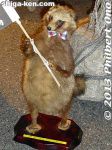
Somebody made a tanuki model and placed it near the float.
|
|
|
|
|

The Otsu Matsuri is a festival of Tenson Shrine in Otsu. The path to the shrine is packed with worshippers.
|
|

Tenson Shrine torii gate. 天孫神社
|
|

People crowd the route to the shrine hall to worship.
|
|

Praying at Tenson Shrine.
|
|

This house in Kajiya-cho was open to the public to exhibit stuff related to the lead float Saigyo Sakura Tanuki-yama.
|
|

Inside the house was the tanuki mask worn by Jihei.
|
|

Wooden tanuki (raccoon dog) mask worn by Jihei, the man who started Otsu Matsuri.
|
|

Also on display in the house was this folding screen.
|
|

Karakuri dolls from the Kakkyo-yama float.
|
|

Karakuri dolls from the Kakkyo-yama float.
|
|

Notice the gold carvings on the ceiling.
|
|

During Yoimiya at night, each float had musicians performing.
|
|

Musicians at the Genji-yama float. 源氏山
|
|

Genji-yama float. 源氏山
|
|

Karakuri puppet from the Genji-yama float. 源氏山
|
|

Karakuri puppet from the Genji-yama float. This is Lady Murasaki writing The Tale of Genji. 2008 is a special year for this float because of the novel's 1000th anniversary. 源氏山
|
|
|

This Gekkyuden-zan float had instruments (bells, drums) which anybody could try and play.
|
|

Karakuri dolls from Gekkyuden-zan float.
|
|

Tapestry designated as an Important Cultural Property. The Trojan War's Sack of Troy (from Greek mythology) is depicted. From the Gekkyuden-zan float.
|
|

The second day of the Otsu Matsuri Festival is called the Honmatsuri, featuring a procession of the thirteen floats as the festival climax. The highlight are the performances by the karakuri mechanical dolls on the floats.
|
|

These pictures were taken on Oct. 12, 2008. This is the first float in the procession, called Saigyo Sakura Tanuki-yama. 西行桜狸山
|
|

Saigyo Sakura Tanuki-yama. Notice the three wheels instead of four. 西行桜狸山
|
|

Float's front wheel, made of wood. The floats creek as they move.
|
|

The procession starts at 9 am and lasts until 5:30 pm. The procession route is different during the morning and afternoon.
|
|

The route goes through central Otsu (walkable from Otsu Station.) A map of the route is available at the info counter in Otsu Station.
|
|

It was in 1638 when the tri-wheel hikiyama floats started to be constructed for the festival. As Otsu prospered, more floats were built until 1776 when the last Otsu Matsuri float (Gekkyuden-zan) was built.
|
|

The floats are steered by men behind the wheels.
|
|

From noon to 1:45 pm, the floats gathered here on Chuo Odori, a wide road leading to Otsu Station. It was a lunch break and a chance for us to look at the floats up close.
|
|

The floats gathered at Chuo-dori one after another.
|
|
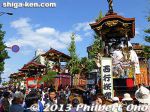
Otsu Matsuri floats at Chuo-dori
|
|

Otsu Matsuri floats
|
|

They also threw chimaki to the crowd. Chimaki are small bundles of straw wrapped with a thin hand towel. They were all blessed by Tenson Shrine.
|
|

The crowd wait for chimaki to be thrown. This is something even Kyoto's Gion Matsuri does not do. (They used to do it.)
|
|

A chimaki supposed to ward off bad luck, so we all want to catch one. You hang it above an entrance or under the eaves.
|
|

The crowd desperate to catch a chimaki. People tend to push and shove, and fight for one.
|
|

Hey, throw one here!! The thirteen floats throw tens of thousands of these chimaki during the procession. It makes this festival unusual. Most other float festivals don't do it.
|
|

Alright! I caught one! No more bad luck and misfortune to me!! It might make me immune to black cats always crossing my path. The chimaki lasts for one year after which you supposed to return it to the shrine to be burned during the Dondo-yaki Festival.
|
|

A small parade comes thrpugh.
|
|
|
|

Shrine priest on horseback.
|
|

After the lunch break, the floats geared up to move on. This is the Genji-yama float with banners declaring the Millennium anniversary of Tale of Genji.
|
|

More chimaki for the crowd.
|
|
|

Parading on Chuo Odori road.
|
|
|
|

At various spots along the procession route, each float stops to perform the karakuri puppets.
|
|

On Chuo Odori road, this spot had spectator seats (admission charged) to watch the karakuri performances which last only for a few minutes. At other spots, you can watch it for free.
|
|

Karakuri dolls performing. They are manipulated with strings and other devices below or on the side. (There are no strings above the puppets.)
|
|
|
|
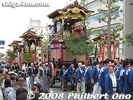
On with the procession.
|
|

Musicians chime in.
|
|

The Chuo Odori road is wide, making it easy to view the floats. It's not as crowded as Gion Matsuri in Kyoto. There's a more earthly atmosphere at Otsu Matsuri.
|
|

The Jingu Kogo-yama float has vermillion-painted wheels. It was also the last float in this year's procession.
|
|
|

On a narrower street, there are houses with open windows on the upper floor which is almost the same level as the float.
|
|

Those people in the windows get a lot of chimaki thrown in. Otsu Matsuri.
|
|

This is another spot where the karakuri dolls perform.
|
|

Must be a great view from the window.
|
|
|

Sign says, "Throw us chimaki!"
|
|

Toward the end of the route is an even narrower road. This is where I photographed and shot videos of all the floats and all the karakuri performances.
|
|

So let me introduce all the thirteen floats of the Otsu Matsuri.
|
|

Always first in the Otsu Matsuri procession is the Saigyo Sakura Tanuki-yama float. It has cherry blossoms in the front. 西行桜狸山
|
|

The top of the Saigyo Sakura Tanuki-yama float also has a stuffed tanuki (raccoon dog). This is how to identify this float at Otsu Matsuri.
|
|

The karakuri shows a hermit emerging from the flowers and talking with Priest Saigyo.
|
|
|
|
|
|
|
|

The float is followed by a cart loaded with chimaki.
|
|

The second float is Yutate-yama. 湯立山/玉屋町
|
|
|
|
|
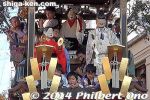
Modeled after Tenson Shrine, the karakuri puppets reenact the shrine's yudate Shinto ritual.
|
|
|

The third float is Genji-yama. 源氏山/中京町
|
|
|

Genji-yama musicians.
|
|

Side view of Genji-yama.
|
|

The karakuri has Lady Murasaki writing A Tale of Genji at Ishiyama-dera temple in Otsu.
|
|
|

Lady Murasaki write Tale of Genji as these little figurines circle around her.
|
|
|

The fourth float is Ryumon Taki-yama. 龍門滝山/太間町
|
|
|
|
|
|
|

The float has much Chinese influence in its artwork.
|
|
|
|

The fifth float is Shojo-yama. 猩々山/南保町
|
|
|
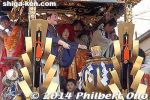
The karakuri shows saké seller Takafu pouring saké for Shojo, an alcohol-loving, legendary sea creature with a red face and red hair. Shojo then drinks the saké.
|
|
|

Sake is poured from a keg for the Shojo to drink.
|
|

The sixth float is Nishinomiya Ebisu-yama. 西宮蛭子山/白玉町
|
|
|

The karakuri shows Ebisu (God of Business Prosperity) going fishing for sea bream (an auspicious fish).
|
|
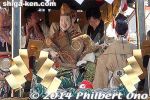
Ebisu (god of fishermen) fishing for sea bream.
|
|
|

The seventh float is Seio Bo-zan. 西王母山/丸屋町
|
|
|

A peach splits opens and out comes a peach boy. The children's story Momotaro is based on this.
|
|
|
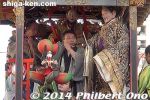
Seiobo is the Chinese goddess Xi Wangmu living on the mythological Kunlun Mountain. She danced for Emperor Wu of Han who desired longevity. She gave him a longevity peach.
|
|

The eighth float is Gekkyuden-zan. 月宮殿山/上京町
|
|
|
|
|
|

The karakuri on Gekkyuden-yama float has two dancers, one wearing a crane crown and the other a turtle crown, dancing in front of the Emperor.
|
|
|
|
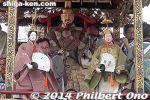
A female wearing a crane crown and a male with a turtle crown start dancing in front of the Chinese emperor to celebrate his longevity.
|
|

Wheel stopper
|
|

Trojan War tapestry
|
|

The ninth float is Shakkyo-zan. 石橋山/湊町
|
|
|

This red-haired Chinese lion comes out of a rock on Mt. Tiantaishan in China and jumps and spins all around amid peony flowers. Quite comical.
|
|
|

The tapestry on the back is said to been made in Flanders, Begium in the 17th century.
|
|

The tenth float was Kakkyo-yama, originally built in 1693. 郭巨山/後在家町・下小唐崎町
|
|

Ornate, carved ceiling.
|
|
|
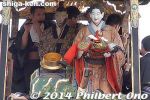
Kakkyo digging a hole with a hoe and finding a pot of gold while his wife holds their son to be buried.
|
|

Kakkyo (Guo Ju in Chinese) was one of the 24 Chinese filial exemplars.
|
|

The eleventh float was Sesshoseki-zan, originally built in 1673. 殺生石山/柳町
|
|
|

Beautiful painted ceiling.
|
|
|
|

A young court lady who was actually a fox aiming to kill the Emperor was turned into a rock by this priest.
|
|

The rock is cracked open, and the lady changes into a fox.
|
|

The head flipped up to reveal a fox's head.
|
|

The karakuri is based on the Noh play Sessho-seki.
|
|

The twelveth float was Komeikisui-zan, originally built in 1694. 孔明祈水山/中堀町
|
|
|
|
|
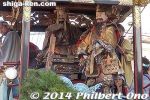
During China's Three Kingdoms period, Zhuge Liang, chancellor of the state of Shu Han, fought Cao Cao, the chancellor of the state of Wei.Zhuge Liang looked at flowing water and prayed to the water god to wash away the enemy's huge army. He thereby emerged victorious.
|
|

The thirteenth and last float was Jingu Kogo-yama, originally built in 1749. 神功皇后山/猟師町
|
|

Readily identifiable with its vermillion wheels.
|
|

The float is associated with Empress Jingu of the 4th century. When she gestures to write some characters on a rock with her bow, and the characters magically appear.
|
|

Empress Jingu
|
|
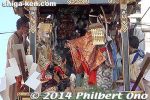
The karakuri shows Empress Jingu using her bow to write kanji characters on a large rock.
|
|

The floats proceed down Teramachi-dori.
|
|

Look at how many chimaki this girl caught!!!
|
|

Otsu Festival poster
|
|
|
|
|